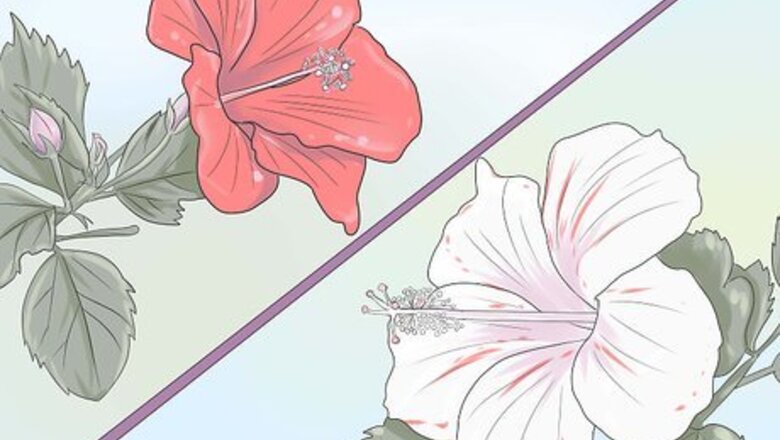
views
Preparing to Plant
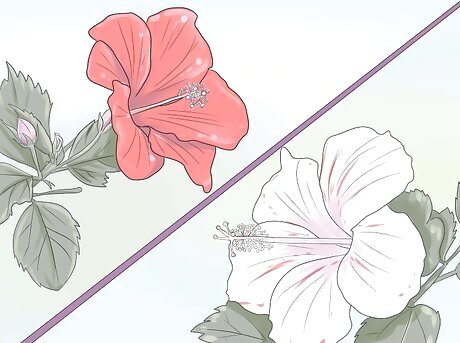
Choose a type of hibiscus to plant. Hibiscus come in a variety of colors and appearances, but what is more important than choosing the look of a hibiscus plant, is finding one that will thrive in your local environment. There are two general types of hibiscus bushes: tropical and hardy. Tropical hibiscus will grow in areas with warm weather and temperatures above 50 °F (10 °C) year-round. Hardy hibiscus are hybrids that have been developed to grow in cold areas whose temperatures may drop below freezing in the winter. Tropical hibiscus have more plentiful blooms, but they die off after only 1-2 days. They are typically in shades of pink, peach, and purple. Hardy hibiscus hold their blooms for longer than tropical hibiscus, but don’t have as many and are more ‘bushy’. They generally come in hues of red, white, and pink.
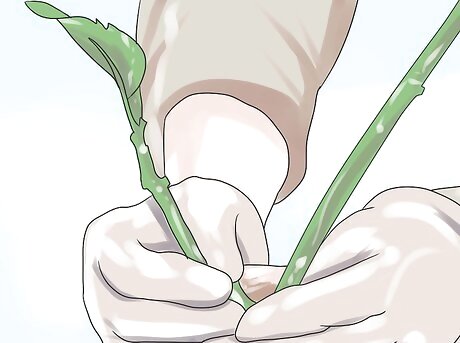
Decide how you’re going to grow your hibiscus. As with most flowering plants, there are three general ways you can grow your hibiscus: from seed, from a transplant, or from a cutting. Growing hibiscus from seed can be fun, because you can create an entirely new cultivar by crossing two existing varieties of hibiscus. On the other hand, growing from seed requires the most work, and may not be successful. If you’re looking for ease and immediate results, you should find a pre-existing potted hibiscus to transplant into your garden. Growing from cuttings is the least likely to be successful, as it requires very specific conditions in order to work out. If you’re new to gardening or growing hibiscus, avoid growing from cuttings. You may not have much variety of choice when growing from a pre-existing potted plant, as nurseries typically only carry a few varieties of hibiscus seedlings or transplants.

Know when to plant. As heat-lovers, hibiscus should not be planted until well after the winter season has ended. Wait until outdoor temperatures are consistently between 60–70 °F (16–21 °C) before considering planting. If the temperature drops to 55 degrees, the plant will stop growing. If it drops to 45 degrees or colder, the plant will die. This is less true for hardy varieties of hibiscus, but is still an important reminder of the necessity of heat for these plants. Call your local agricultural extension for specific advice on when to plant in your area.
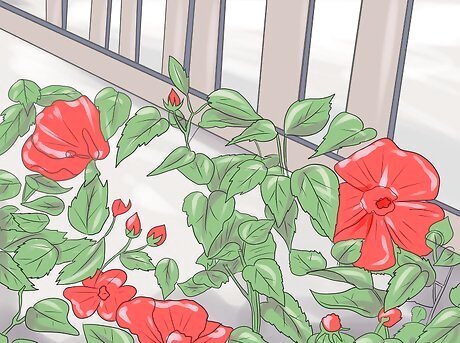
Choose the perfect location. Hibiscus are sun-loving plants, but they can’t handle too much direct sunlight without getting sunburned. Choose a location in your garden that gets 4-6 hours of direct sunlight a day, and ambient sunlight for the rest of the time. Typically this would be on the west or south side of your garden. The hibiscus can be shaded by larger trees if necessary, but will need space to spread out, as they may eventually take up two or three times the space of their original size. Some hibiscus plants have lived over 40 years, meaning that you could be dealing with a very large bush. Make sure you find a permanent location for your hibiscus to start. Try to find a location that has good drainage; water-pooling will drown out your hibiscus. On the other hand, avoid a location that is primarily sand. Make sure to test the soil’s drainage and permeability before planting. To do this, dig a hole, pour a gallon of water in it, if the water doesn't disappear within an hour, then amend the soil to deal with the extra clay in it. If the water drains too quickly when you pour it in, then consider adding come clay.
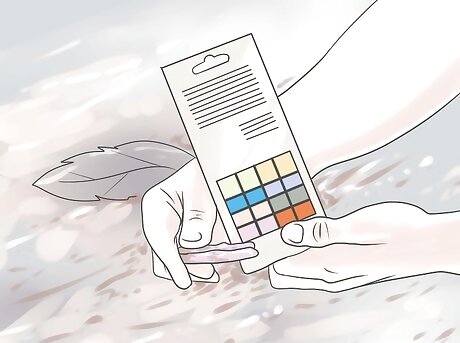
Amend the soil. Hibiscus have picky soil requirements, so it is worth it to take time to amend the soil prior to planting them. Test the pH of your garden soil; hibiscus prefer acidic soil, so anything above 6.5 on the pH scale will have to be made more acidic. Additionally, you’ll need to supplement the soil with plenty of nutrients and fertilizer. Mix in a garden compost several weeks (or months, if you have the time) prior to planting. You’ll also want to add a fertilizer to the soil mix, that is low in phosphorus and high in potassium. If the pH of your soil is too basic, add in peat moss to balance it out. Common low-phosphorus/high-potassium fertilizers include a 10-4-12 mixture, or a 9-3-13 mixture.
Planting Your Hibiscus
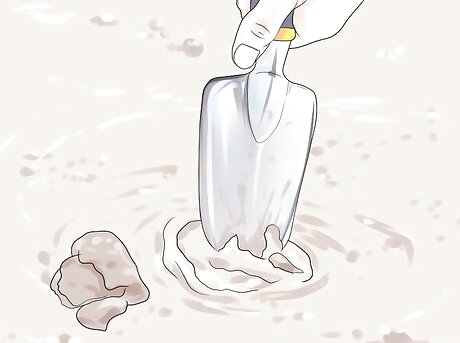
Dig your holes. Use a shovel or gardening trowel to prepare your holes for planting. Each hole (for a single plant or hibiscus seed) should be as deep as the roots go, and at least twice, if not three times, as wide. The loose soil around the plant will allow for better drainage, and should not be tamped down. Plant each hibiscus plant at least 2–3 feet (0.6–0.9 m) away from each other. In cold climates, plant the bulbs deeper than you normally would. In warm and soggy climates, plant the bulbs closer to the surface.
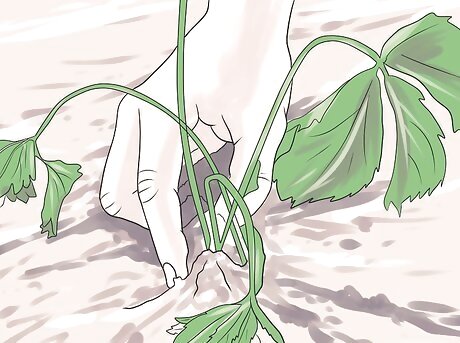
Plant your hibiscus. Carefully place each hibiscus plant into its own individual hole, being careful not to damage the root ball. Refill the hole with soil, going only as high as the base of the stem. Covering up the stems with soil could kill the plant over time. Give your hibiscus a heavy watering two to three times in a row immediately after planting to help reduce the risk of transplant shock.
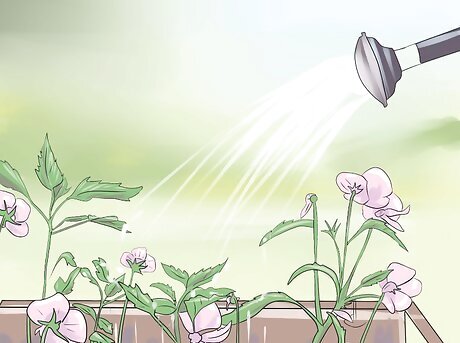
Water your hibiscus on a regular basis. Try to keep your hibiscus plants moist, but not soaking wet. Make sure that the soil your hibiscus are in is damp at all times, as when it dries out, it can cause wilting and heat stroke in the plants. In the winter when the plant is dormant, only water when the soil gets very dried out. Make sure that you wait one to two weeks before you fertilize the plants.
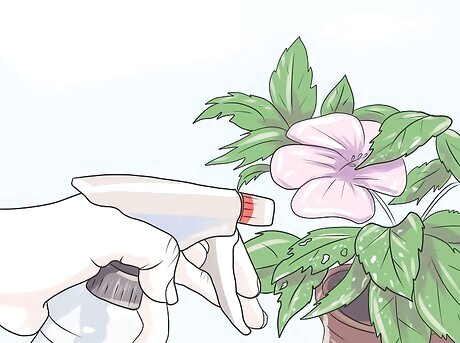
Manage any pests. It may be beneficial to add a layer of mulch to your hibiscus garden, as this will block out weeds and trap in moisture. Pull out any weeds on sight, so that your hibiscus are not forced to compete for space and nutrients. Tropical hibiscus tend to have issues with pest on occasion, more so than hardy varieties. If you notice spotting or decaying leaves, try using an organic insecticide to kill off any disease or bugs that are harming the hibiscus.
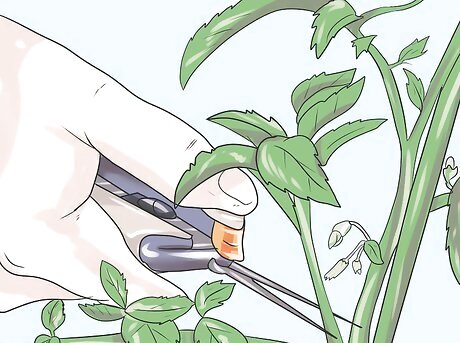
Prune the plants. Although pruning sounds counterintuitive, it actually helps to promote new growth and causes more blossoms to appear. There are several methods of pruning, but they all work by cutting branches just above a node (leaf joint) at an angle away from the center of the bush. This will send a signal to the plant to grow more branches at this location, outwards and away from the center of the bush. If any part of your hibiscus dies, you should do corrective pruning and cut it off. This will remove the unsightly part of the plant, and may even cause it to re-grow from scratch. Never cut off more than ⅔ of a single branch at a time, as this can harm the hibiscus more than it helps.

Enjoy the lovely flowers. Hibiscus will produce flowers for many months, although each individual bloom will likely only last a few days. You can leave the flowers on the bush, or cut them and use them in tea or cooking.

















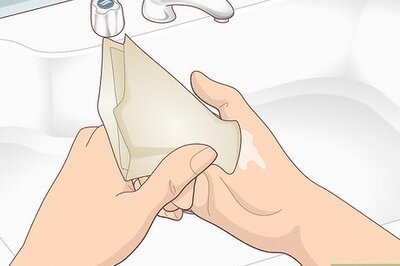
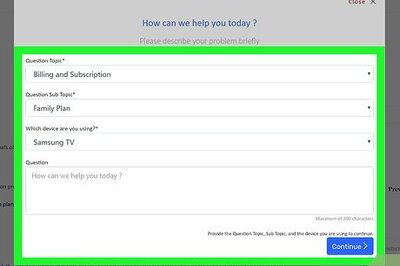
Comments
0 comment